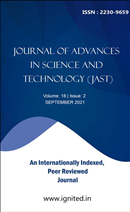A Study on Diversity of Planktons in Water Body of Baglihar Dam- A Review
Keywords:
Zooplankton, Phytoplankton, Baglihar Dam, Biodiversity, Aquatic ecology, Ecological implications, Conservation strategiesAbstract
Zooplankton is a vital component of an aquatic environment and is critical for the transmission of energy. Plankton production depends critically on the physicochemical properties and nutritional state of a water body. Many fish species naturally eat plankton, especially zooplankton. Baglihar Dam is a freshwater body of water that is notable because of its high commercial value and is situated in the Ramban region of Jammu and Kashmir, India. The region's high agricultural activity continues to have an influence on the water's quality even if the water is changed often. Additionally, it offers the necessary amount of protein for the rapid development of larval carps. Phytoplankton is the main producer and the lowest trophic level in the food chain in freshwater environments. Studies on planktonic composition and morphometric, physical, and chemical characterization of water bodies are necessary to get a fundamental knowledge of a region's biodiversity. In order to better understand the variety of phytoplankton and zooplankton in the Baglihar Dam reservoir, a current study is being conducted.
Downloads
References
Abbasi, S.A. (1998). Water quality sampling and analysis. Discovery Publishing House, New Delhi.
Agarwal, A.K. and Rajwar, G. S. (2010). Physico-Chemical and Micro biological Study of Tehri Dam Reservoir, Garhwal Himalaya, India. Journal of American Science, 6(6).
Barai S.R. and Satish Kumar, (2012). Evaluation of the physicchemical characteristics of river Varuna at Varanasi, India, J. Environ. Biol., 34, 259-265.
Bhatnagar A., Chopra G. and Malhotra P. (2013). Assessment of water quality of river Yamuna in Yamunanagar, India with reference to planktons and macrozoobenthos. Sch. J. Eng. Tech., 1(4):204-213.
Dhanam, S., Sathya, A., &Elayaraj, B. (2016). Study of physico-chemical parameters and phytoplankton diversity of Ousteri lake in Puducherry. World Scientific News, 54, 153-164.
Dhar, G., Barat, S. and Dhar, M.K. (2004), Influence of Organo phosphorus insecticide phosphamidon on lentic water, Journal of environmental biology, 25(3), pp 359-363.
Fritsch, F.E. (1907). The sub arial and fresh water algae flora of the tropic Ann. Bot. 21:235-275.
Gupta M. (1992). Limnology of a village pond near to Bikaner with special reference to Planktonic community and Productivity. M.Phil. Dissertations, Dungar College, Bikaner PP-53.
Jakhar, P. (2013). Role of phytoplankton and zooplankton as health indicators of aquatic ecosystem: A review. International Journal of Innovation Research Study, 2(12), 489-500.
Janagal Bhupender and Khatri Anand Kumar (2015). Phytoplankton diversity of a desert village pond in Bikaner, Rajasthan, India. Int. J. Envir. Sci., 4(12):43-45.
Jha. A.N. and verma, P.K. (2000). Physico-chemical property of drinking water in Town area of Godda District under Santal Pargana, Bihar (India). Pollution Research. 19 (2) : 245-247.
Manickam, N., Sarvana, B. P., Santhanam, P. B., Huvaneshwari, R., &Chitrarasu, P. (2017). Physico-chemical characteristics and phytoplankton biodiversity in Sulur lake of Coimbatore, South India. Research Journal of Biotechnology, 12(11), 72-82.
Mulani, S.K., Mule, M.B. and Patil S.V. (2009). Studies on water quality and Zooplankton community of the Panchganga river in Kolhapur city. J. Environ. Biol. 30 (3) : 455-459.
Pandey, B. N., Ambasta, O. P., Thakur, A. K., Sanjay, K., &Ritu, K. (2009). Zooplankton diversity in relation to certain physico-chemical parameters of swamp of Kishangani District, Bihar. Environment Conservation Journal, 10(1&2), 9-14.
Rajagopal, T., Thangamani, A., Sevarkodiyone, S. P., Sekar, M., &Archunan, G. (2010). Zooplankton diversity and physico-chemical conditions in three perennial ponds of Virudhunagar district, Tamilnadu. Journal of Environmental Biology, 31(3), 265-272.
Saxena, M.M. (2006). Diversity of aquatic fauna in the waters of the Indian desert. Jaipur.pp.77.
Sharma, B.K. (2009). Diversity of rotifers (Rotifera: Eurotatoria) of Loktak lake, Manipur, North-eastern India. Tropicl Ecology, 50(2): 277–285.
Sharma, K. K., Devi, A., Sharma, A., &Antal, N. (2013). Zooplankton diversity and physico-chemical conditions of a temple Pond in Birpur (J&K, India). International Research Journal of Environment Sciences, 2(5), 25-30.
Singh M. and Gupta K.C., (2004). Physico-chemical studies of water of river Yamuna at Mathura, Ecol. Envi. And Cons., 10(2), 193-196.
Thirugnanamoorthy, K., &Selvaraju, M. (2009). Phytoplankton diversity in relation to physico-chemical parameters of Gnanaprekasam Temple pond of Chidambaram in Tamilnadu, India. Recent Research in Science and Technology, 1(5).
Vandysh, O. I (2004). Zooplankton as indicator for condition of the Kola Peninsula lake ecosystems under influence of mining-and-metallurgical integrated works. Ecologia 2, 134- 140.






